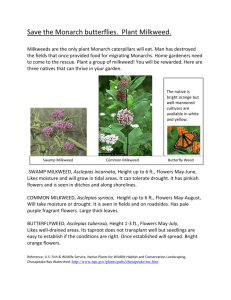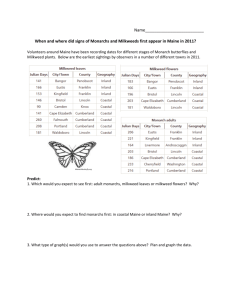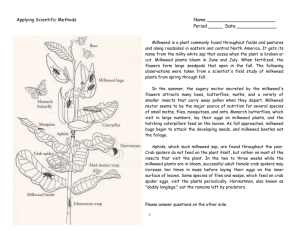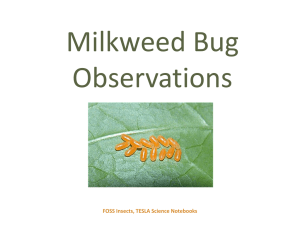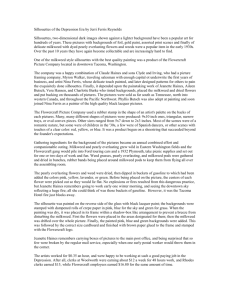Production Variables Affecting Follicle and Biomass Development in
advertisement
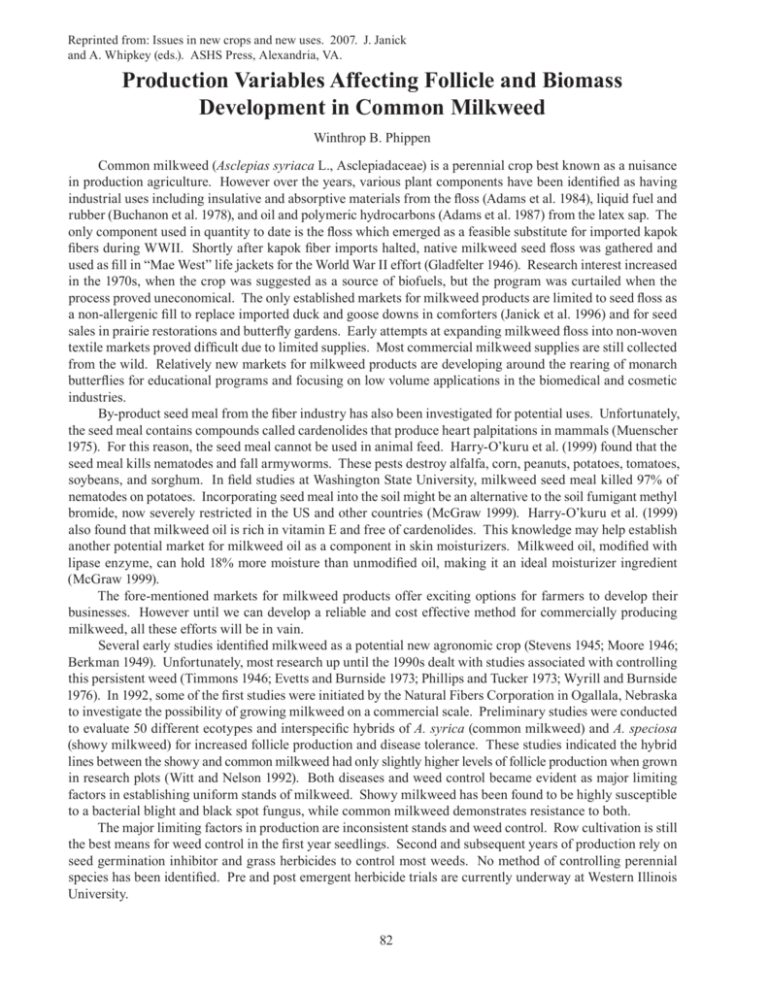
Reprinted from: Issues in new crops and new uses. 2007. J. Janick and A. Whipkey (eds.). ASHS Press, Alexandria, VA. Production Variables Affecting Follicle and Biomass Development in Common Milkweed Winthrop B. Phippen Common milkweed (Asclepias syriaca L., Asclepiadaceae) is a perennial crop best known as a nuisance in production agriculture. However over the years, various plant components have been identified as having industrial uses including insulative and absorptive materials from the floss (Adams et al. 1984), liquid fuel and rubber (Buchanon et al. 1978), and oil and polymeric hydrocarbons (Adams et al. 1987) from the latex sap. The only component used in quantity to date is the floss which emerged as a feasible substitute for imported kapok fibers during WWII. Shortly after kapok fiber imports halted, native milkweed seed floss was gathered and used as fill in “Mae West” life jackets for the World War II effort (Gladfelter 1946). Research interest increased in the 1970s, when the crop was suggested as a source of biofuels, but the program was curtailed when the process proved uneconomical. The only established markets for milkweed products are limited to seed floss as a non-allergenic fill to replace imported duck and goose downs in comforters (Janick et al. 1996) and for seed sales in prairie restorations and butterfly gardens. Early attempts at expanding milkweed floss into non-woven textile markets proved difficult due to limited supplies. Most commercial milkweed supplies are still collected from the wild. Relatively new markets for milkweed products are developing around the rearing of monarch butterflies for educational programs and focusing on low volume applications in the biomedical and cosmetic industries. By-product seed meal from the fiber industry has also been investigated for potential uses. Unfortunately, the seed meal contains compounds called cardenolides that produce heart palpitations in mammals (Muenscher 1975). For this reason, the seed meal cannot be used in animal feed. Harry-O’kuru et al. (1999) found that the seed meal kills nematodes and fall armyworms. These pests destroy alfalfa, corn, peanuts, potatoes, tomatoes, soybeans, and sorghum. In field studies at Washington State University, milkweed seed meal killed 97% of nematodes on potatoes. Incorporating seed meal into the soil might be an alternative to the soil fumigant methyl bromide, now severely restricted in the US and other countries (McGraw 1999). Harry-O’kuru et al. (1999) also found that milkweed oil is rich in vitamin E and free of cardenolides. This knowledge may help establish another potential market for milkweed oil as a component in skin moisturizers. Milkweed oil, modified with lipase enzyme, can hold 18% more moisture than unmodified oil, making it an ideal moisturizer ingredient (McGraw 1999). The fore-mentioned markets for milkweed products offer exciting options for farmers to develop their businesses. However until we can develop a reliable and cost effective method for commercially producing milkweed, all these efforts will be in vain. Several early studies identified milkweed as a potential new agronomic crop (Stevens 1945; Moore 1946; Berkman 1949). Unfortunately, most research up until the 1990s dealt with studies associated with controlling this persistent weed (Timmons 1946; Evetts and Burnside 1973; Phillips and Tucker 1973; Wyrill and Burnside 1976). In 1992, some of the first studies were initiated by the Natural Fibers Corporation in Ogallala, Nebraska to investigate the possibility of growing milkweed on a commercial scale. Preliminary studies were conducted to evaluate 50 different ecotypes and interspecific hybrids of A. syrica (common milkweed) and A. speciosa (showy milkweed) for increased follicle production and disease tolerance. These studies indicated the hybrid lines between the showy and common milkweed had only slightly higher levels of follicle production when grown in research plots (Witt and Nelson 1992). Both diseases and weed control became evident as major limiting factors in establishing uniform stands of milkweed. Showy milkweed has been found to be highly susceptible to a bacterial blight and black spot fungus, while common milkweed demonstrates resistance to both. The major limiting factors in production are inconsistent stands and weed control. Row cultivation is still the best means for weed control in the first year seedlings. Second and subsequent years of production rely on seed germination inhibitor and grass herbicides to control most weeds. No method of controlling perennial species has been identified. Pre and post emergent herbicide trials are currently underway at Western Illinois University. 82 Industrial Crops Based upon the work by Von Bargen et al. (1994), a modified ear corn picker has been designed to harvest green milkweed follicles with 30%–35% field loss. An additional fan, stalk ejector, and 15 inch row head has been added or modified to decrease field losses to 15%–20%. A fully portable follicle processor is under development. The primary objective of this study was to examine numerous production variables affecting follicle and biomass development in common milkweed production fields. Experiments established in 2001 addressed the effects of intra-row plant spacing on follicle formation and the effects of coal dust on plant establishment. The 2002-established studies focused on planting times, inter-row spacing, nitrogen requirements, and pruning in the first year. METHODOLOGY Plant Material Common milkweed seeds were collected from wild populations in the fall of 2000 in McDonough County, Illinois. Seeds were stratified at 4°C for 4 months prior to planting. Seeds were placed on germination paper in clear plastic boxes under 24 hr light conditions at 26°C in late March. Germinated seedlings were transplanted to 36 celled Root-tainers® and allowed to grow until approximately the second true leaf was fully expanded under greenhouse conditions. Milkweed seedlings were hand transplanted in replicated 3 m × 3 m plots in late May. All plots were located at the Western Illinois University research farm on non-irrigated rozetta soils in Macomb, Illinois. Plots were maintained by hand weeding in the first year and by the application of herbicides for the remaining years. Intra-row Plant Spacing Studies In late May 2001, milkweed transplants were planted into 48 replicated plots with varied within row plant spacing. Each plot consisted of four rows spaced 76 cm apart and 3 m long, while intra-row plant spacings were 15, 20, and 30 cm. Each intra-row plant spacing was replicated in 16 plots randomly distributed in the field. Coal Dust Applications Observations taken from wild populations indicated milkweed plants tend not to grow in close proximity (< 50 cm) to each other. To address this issue, coal dust was applied to plots utilizing a drop fertilizer spreader in an attempt to bind any potential phytotoxins that may limit the number of plants in a production field. Coal dust was applied prior to emergence at the rates of 243 kg ha-1 and 486 kg ha-1 on four separate replicated plots for each rate. Coal dust was also reapplied monthly at the 243 kg ha-1 rate for four months to four plots. Four untreated control plots completed the study. Applications of coal dust were applied only in the first two years of growth. In Illinois, coal fines are relatively abundant and were readily donated by local coal mines for the milkweed experiments. Inter-row Plant Spacing Studies In late May 2002, milkweed transplants were planted into 12 replicated plots with varied inter-row plant spacing. Intra-row plant spacing was 20 cm in each plot with inter-row spacings of 19, 38, and 76 cm (Fig. 1). Each inter-row plant spacing was replicated in 4 plots randomly distributed in the field. Planting Date Studies From previous studies in 2001, observational data appeared to indicate that the stage of transplant growth at the time of planting impacted plant survival. To address this issue, milkweed seeds were germinated on 3 separate dates in 2002: March 15, April 1, and April 15. The resulting seedlings were hand transplanted to the field in 3 m × 3 m replicated plots in late May. Each plot consisted of 7 rows and was 3 m long with plants spaced 20 cm apart. A total of 4 plots were planted for each planting date. Nitrogen Studies To improve seedling establishment, nitrogen was applied at 9 kg ha-1 and 18 kg ha-1 to 8 replicated plots. Each plot consisted of 7 rows and was 3 m long with plants spaced 20 cm apart. The 18 kg ha-1 application 83 Issues in New Crops and New Uses consisted of 2 9 kg ha-1 applications, 1 at emergence and the 2nd during anthesis. Nitrogen was only applied for the first 2 years. Incorporated prilled urea was used as the nitrogen source at the time of planting while 28% urea-ammonium nitrate was utilized for the second application. Pruning Studies To increase above ground biomass of milkweed plants in the first year of production, 4 replicated plots were pruned with lopping shears to the height of 45 cm throughout the first year. Each plot consisted of 7 rows and was 3 m long with plants spaced 20 cm apart. Second year growth was not pruned. Data Collection For each study, data was collected on an individual plant basis. Total number of stalks, number of stalks with follicles, number of follicles per stalk, and total dry weight of follicles and stalks were recorded for each test plot. Follicles for each plot were placed in mesh onion sacks, dried, and processed to separate seeds, floss, and hulls. Stalks from each plot were hand harvested, bundled, and allowed to dry for 60 days before obtaining a dry weight. The experimental data were statistically analyzed by analysis of variance. Estimation of the significant differences between means was based on a probability of P<0.05. Results and discussion The data collected from the intra-row plant spacing study indicated the total number of stalks dramatically increased in the 2nd year for all row spacings (Table 1). Plots planted on 30 cm had a greater than 4 fold increase in the number of stalks per plot from 40 to 174 by the second season with 80% of the stalks producing follicles. The greatest mean number of follicles (907) collected from plots occurred in 30 cm plots in the second year. As plots matured over the next three years, a steady decline occurred in total stalks and stalks with follicles across all plots. By the fourth growing season, total stalks with follicles fell by 50% with only 72 stalks remaining. In the first year of production, the mean number of follicles per plant was significant for each row spacing treatment. However across the next three production years, there was a steady decline in the average number of follicles and less significance between row spacing treatments. Average dry stalk biomass per plant increased with row spacing; however, total dry biomass per plot decreased with larger row spacing (data not shown). The dramatic decline in all the production variables in 2005 may be explained by an extreme drought in the Midwest. Although deep rooted, milkweed plants displayed several symptoms of stress including: early flowering, short stature, aborted flowers, leaf wilt, and early senescence. An early observation in 2006 suggests most plots will maintain the low numbers seen in 2005. In addition to the weather, the steady decline in production may be the result of increased weed pressures. In the second year of production, all plots are sprayed with seedling growth inhibitor herbicides prior to shoot emergence. Although the herbicides controlled most early season annual broadleaf species, late season annuals, perennial weeds, and tree species have a tendency to accumulate. A B Fig. 1. Intra-row and inter-row plant spacing plots with common milkweed; (A) 76 cm intra-row spacing study in second year illustrating spread of emerging stalks; (B) 2002 inter-row spacing study in first year; 19 cm in the foreground, 76 cm in the middle, and 38 cm inter-row spacing plot in the background. 84 Industrial Crops Follicle processing data from the intra-row plant spacing experiment can be seen in Table 2. The greatest yield of 56.4 kg of dried follicles occurred in the 2nd year in plots planted on 30 cm rows. These follicles were processed into 15 kg of seed and 12.4 kg of floss. When increased to represent a hectare, a total of 1,138 kg of seed and 796 kg of floss could be produced. The current price of $264 kg-1 for seed and $22 kg-1 for floss will result in revenues of $301,144 and $17,567 per ha, respectively. Of course, this would only be temporary. As milkweed products became more readily available, prices will decrease dramatically. This revenue represents well maintained and hand harvested milkweed plots which is not likely to occur in large scale production fields. Preliminary data from a mechanically harvested large scale milkweed field, suggests a decline of 90% in yield. After collecting milkweed seed from populations throughout Illinois, it was noticed that the largest incidence of common milkweed occurred along railroad lines from coal mines. Typically the outside bend in the tracks where coal had gathered from falling off the rail cars would have extremely dense populations of milkweed. These highly productive patches were not found in any other habitats throughout the region. It was hypothesized that the coal particles were binding possible phytotoxins in the soil allowing plants to grow in closer proximity to each other. However when coal particles were applied on the soil surface at various rates all at once or repeatedly over the growing season, no significant differences in any of the surface applied applications were recorded in stalk density or follicle production (data not shown). It is theorized the mechanism for controlling shoot emergence would occur at depths nearer that of the crown of the plant which is approximately 10 cm below the surface. Future studies should look at the incorporation of coal particles and identifying any possible phytotoxins in the growing media. Inter-row planting data can be seen in Table 3. By the 3rd and 4th year, plots planted on 38 cm and 76 cm inter-row spacing were not found to be significantly different in total number of stalks or follicles produced. Even the average numbers of follicles per stalk did not differ significantly. However, the higher planting density of 19 cm led to a dramatic decline in all variables collected across each year. The greatest mean number of follicles per plot (631) was seen in the 3rd year of plots planted with 38 cm between rows and 20 cm between plants within the row. The planting date studies were established primarily to study the survivability of transplants in the second year of production. The effective sowing date of milkweed had no significant effect after the first growing season. All transplants survived the first year of growth. However, in the second growing season, only a significant effect was seen in total stalk production and not in follicles produced (Fig. 2). Over the next two years of production, there was only a slightly higher production of follicles and stalks in the later planting dates. The differences were found not to be significant due to the variability seen between replicates within a treatment. For milkweed to be economical for floss production, direct seeding of fields will be necessary. Transplanting fields of milkweed is feasible but not very practical. Application of nitrogen at 9 kg ha-1 and 18 kg ha-1 had no significant effect on either stalk or follicle production (Fig. 3). Common milkweed is characterized by an aggressive tap root system with minimal root structures in the first 15 cm of soil. By the end of the first year of growth, the milkweed tap root is commonly 2 m in depth. Any application of nitrogen only appeared to increase the persistence of weed pressure. As expected, pruning milkweed the first year did increase overall vegetative production. Although, no significant increase occurred in the number of stalks emerging from the ground (data not shown). When compared to control plots, the second year production of follicles was not significant due to plot variability; the control plots had an average of 97 follicles more than the pruned plots in the second growing season (Fig. 4). These results were supported by the fact that the overall root length and diameter of roots from pruned plants towards the end of the first growing season were shorter and narrower than the control plots. This suggests the milkweed plants expended energy producing axillary branches; thus diminishing their ability to produce roots to support follicles in the following year. Although not supported by replicated plot trials, one attempt to increase the density of milkweed in production fields was to apply a deep ripper or disk to effectively cut roots. This was attempted utilizing a large disk from a bare root tree transplanter. Unfortunately, due to the vertical nature of the milkweed tap root, the large disk and ripper only damaged the root crown and significantly diminished milkweed plants in the subsequent year. This technique may have also contributed to the spread of root diseases between plants. 85 72a 2005 600ab 708b 470b 311ab 2002 2003 2004 No. follicles 4.5c 2002 4.7b 2003 4.6b 2004 4.3b 2005 Mean no. follicles per stalk 86 9.7 9.4 5.5 3.9 17.2 21.6 195a 19 327a 2003 190a 2004 162a 2005 142a 2003 148a 2004 128a 2005 473b 2003 592a 2004 501a 2005 3.3c 2003 3.9b 2004 3.9b 2005 38 105b 242b 142ab 116b 132ab 123ab 101b 563a 631a 478a 4.3b 5.1a 4.8a 76 60c 182c 129b 102b 104b 103b 95b 588a 584a 503a 5.4a 5.7a 5.3a z Numbers in columns are a mean of 4 replicated plots planted on April 15, 2002. Means in columns followed by the same letter are not significantly different at the 0.05 level. 2002 (cm) Table 3. Stalk and follicle production per plot for inter-row plant spacing treatments for 2002–2005. All plots measured 3 m × 3 m. Mean no. Row z Total no. stalks No. stalks with follicles No. follicles follicles/stalk spacing 5.6 6.7 8.7 9.5 20 51.0 48.0 30.5 16.9 12.2 10.2 8.1 5.1 11.3 12.0 5.3 3.6 20.0 24.6 13.2 30 56.4 49.1 34.7 22.0 15.0 11.0 10.9 6.6 12.4 11.8 7.2 4.6 19.9 25.0 13.2 z Numbers in columns represent the total of all 16 plots for a particular plant spacing. y Hull matter consists of follicle outer and inner membranes, including placental material. Dust and dirt debris was not included. 8.5 2002 2003 2004 2005 Hull matter y (kg) 7.3 10.6 2002 2003 2004 2005 Floss (kg) 11.4 18.5 44.1 15 27.7 2002 2003 2004 2005 2002 2003 2004 2005 41.2 Seed (kg) Follicles (kg)z Plant spacing (cm) Table 2. Milkweed follicle processing for plots in intra-row plant spacing treatments for 2002–2005. 20 60b 213a 199a 123a 89b 156a 155a 100a 61a 819ab 813a 461b 289b 5.3b 5.3b 5.0b 4.7ab 30 40c 174b 163b 112b 82b 140a 131b 106a 72a 907a 853a 574a 370a 6.5a 6.5a 5.8a 5.1a z Numbers in columns are a mean of 16 replicates. Means in columns followed by the same letter are not significantly different at the 0.05 level. 99a 130a 151ab 15 80a 194ab 185ab 130ab 112a 2002 2003 2004 2005 No. stalks with follicles Total no. stalksz Plant spacing (cm) 2001 2002 2003 2004 2005 Table 1. Stalk and follicle production per plot for intra-row plant spacing treatments for 2001–2005. All plots measured 3 m × 3 m. Issues in New Crops and New Uses Industrial Crops Fig. 3. Average follicle production after nitrogen applications in the first two years of production. Fig. 2. Average follicle and total stalk production across planting dates for three years. Plots measured 3 m × 3 m. Numbers represent an average of 4 repli- Fig. 4. Average follicle production after pruning in the first year. cates. CONCLUSIONS Milkweed, a perennial crop with several potential markets, offers a tremendous advantage for farmers looking to expand their production with minimal annual inputs. To maximize the percentage of stalks with follicles and the total number of follicles produced in a milkweed field, planting spacing of 20–30 cm within the row and 76 cm between rows is recommended. The 76 cm inter-row spacing will also allow for row cultivation in the first year of production. Milkweed requires minimal pesticide inputs and does not require additional nitrogen. The recent development of a mechanical harvester and portable processing unit will allow farmers to process material directly and add value back to the family farm. The full market potential of developing milkweed products has yet to be determined. A deliberate approach for the lower volume biomedical and cosmetics industries needs to be taken. Although milkweed floss and seed offer tremendous attributes, sustained adequate production volumes will be difficult to achieve for large volume industries. References Adams, R.P., M.F. Baladrin, and J.R. Martineau. 1984. The showy milkweed, Asclepias speciosa, a potential new semi-arid land crop for energy and chemicals. Biomass 4:81–104. Adams, R.P., A.S. Tomb, and S.C. Price. 1987. Investigation of hybridization between Asclepias speciosa and A. syriaca using alkanes, fatty acids and triterpenoids. Biochem. Syst. Ecol. 15:395–399. 87 Issues in New Crops and New Uses Berkman, B. 1949. Milkweed: A war strategic material and a potential industrial crop for submarginal lands in the United States. Econ. Bot. 3:223–239. Buchanon, R.A., I.M. Cull, F.H. Otey, and C.R. Russell. 1978. Hydrocarbon- and rubber-producing crops. Econ. Bot. 32:131–145. Evetts, L.L. and O.C. Burnside. 1973. Competition of common milkweed with sorghum. Agron. J. 65:931– 932. Gladfelter, C.F. 1946. Milkweed floss collections in Kansas. Kansas Acad. Sci. Trans. 49:217–218. Groh, H. and W.G. Dore. 1945. A milkweed survey near Ontario in adjacent Quebec. Sci. Agr. 25:463–481. Harry-O’kuru, R.E., H. Mojtahedi, S.F. Vaughn, P.F. Dowd, G.S. Santo, R.A. Holser, and T.P. Abbott. 1999. Milkweed seedmeal: A control for Meloidogyne chitwoodi on potatoes. Indust. Crops Prod. 9:145–155. Janick, J., M.G. Blase, D.L. Johnson, G.D. Jolliff, and R.L. Myers. 1996. Diversifying U.S. Crop Production. Council for Agricultural Science and Technology, Issue Paper 6. Knudson, H.D. and R.D. Zeller. 1993. The milkweed business. p. 422–427. In: J. Janick and J.E. Simon (eds.), New crops. Wiley Press, New York. McGraw, L. 1999. New Uses for Milkweed. Agricultural Research Service News October 1st. Moore, R.J. 1946. Investigations on rubber bearing plants. IV. Cytogenetic studies in Asclepias Torr. L. Can. J. Res. (Sect. C.) 24:66–73. Muenscher, W.C. 1975. Poisonous plants of the United States (rev. ed.). Collier MacMillan, New York. p. 195–199. Phillips, R.L. and D.P.H. Tucker. 1973. An evaluation of new herbicides for milkweed vine control. Proc. Florida State Hort. Soc. 86:29–33. Stevens, O.A. 1945. Cultivation of milkweed. North Dakota Agr. Expt. Sta. Bul. 333. Timmons, F.L. 1946. Studies of the distribution and floss yield of common milkweed (Asclepias syriaca L.) in northern Michigan. Ecology 27:212–225. Von Bargen K., D. Jones, R. Zeller, and P. Knudsen. 1994. Equipment for milkweed floss-fiber recovery. Indus. Crops Prod. 2:201–210. Witt, M.D. and H.D. Knudsen. 1993. Milkweed cultivation for floss production. p. 428–431. In: J. Janick and J.E. Simon (eds.), New crops. Wiley Press, New York. Witt, M.D. and Nelson. 1992. Milkweed as a new cultivated row crop. J. Prod. Agr. 5:167–171. Wyrill, J.B., III and O.C. Burnside. 1976. Absorption, translocation, and metabolism of 2,4-D and glyphosate in common milkweed and hemp dogbane. Weed Sci. 24:557–566. 88
